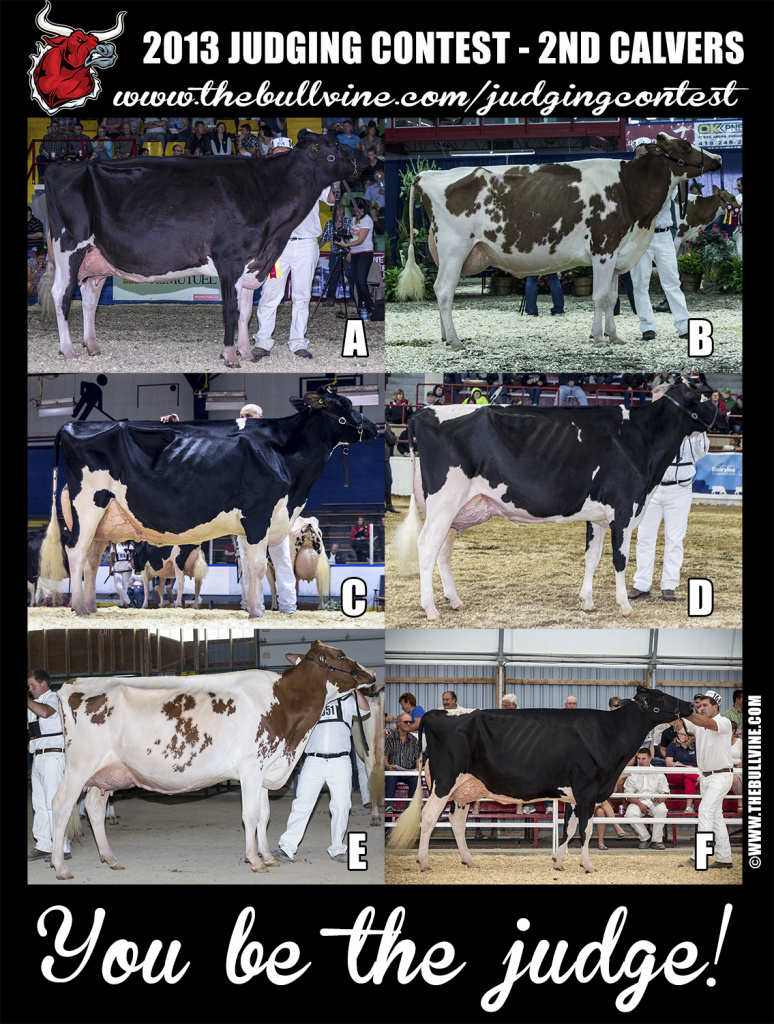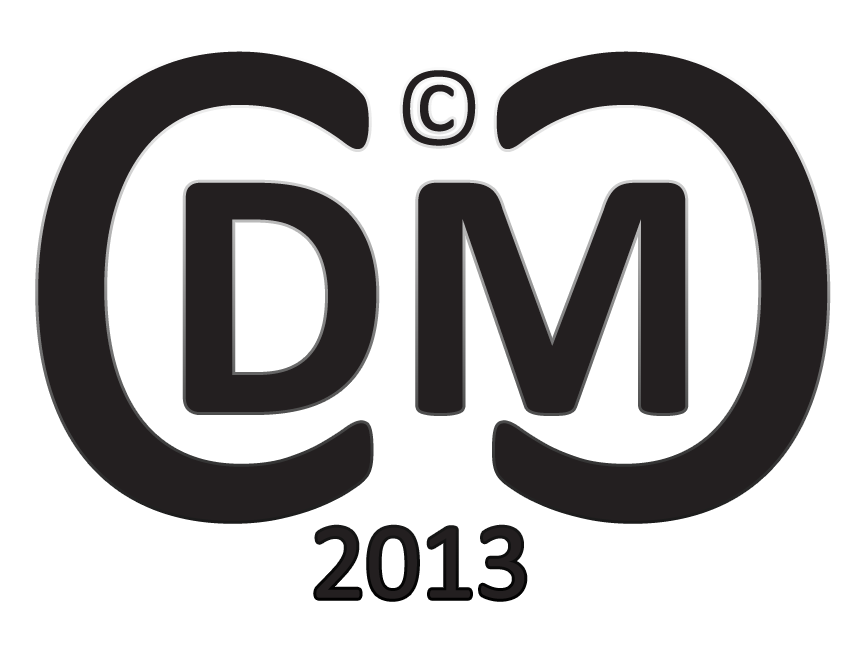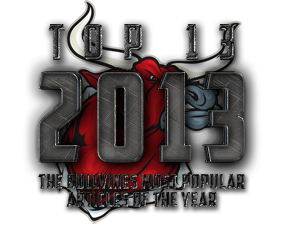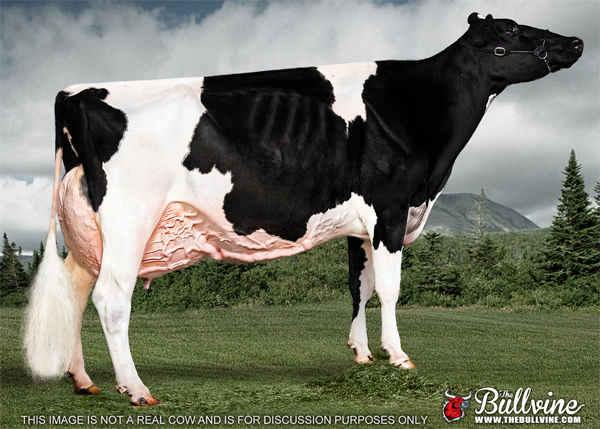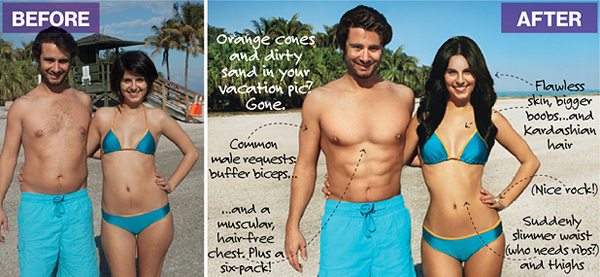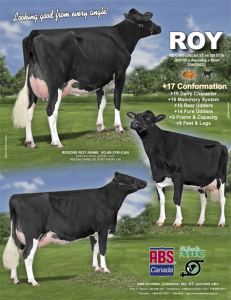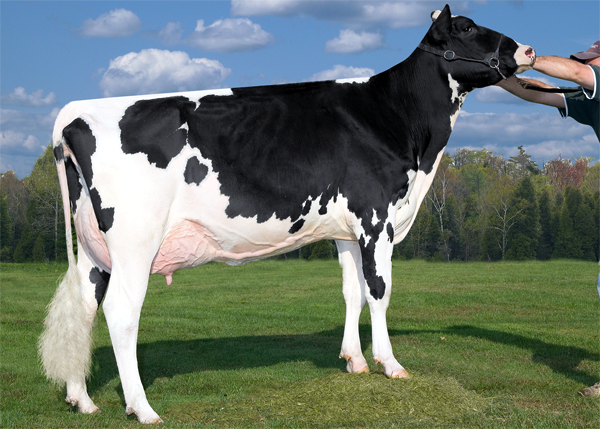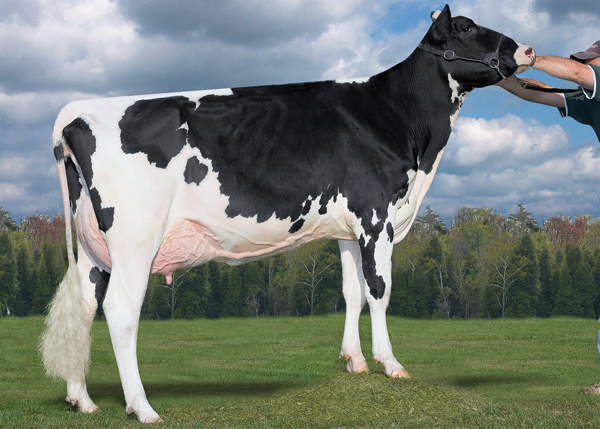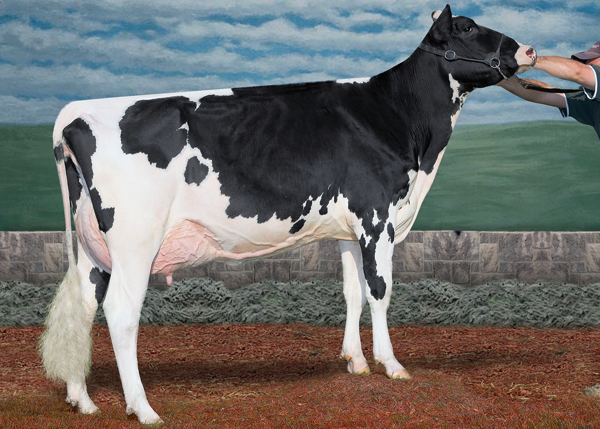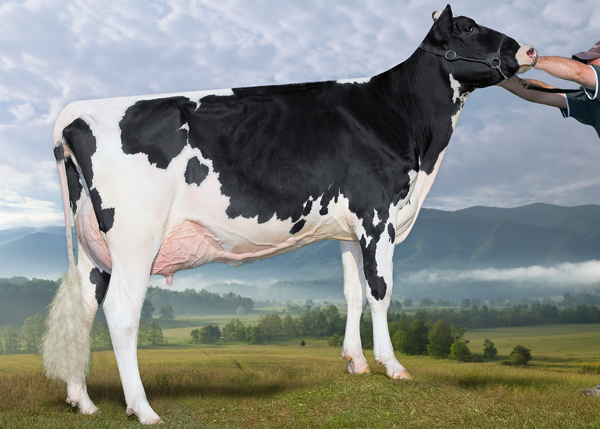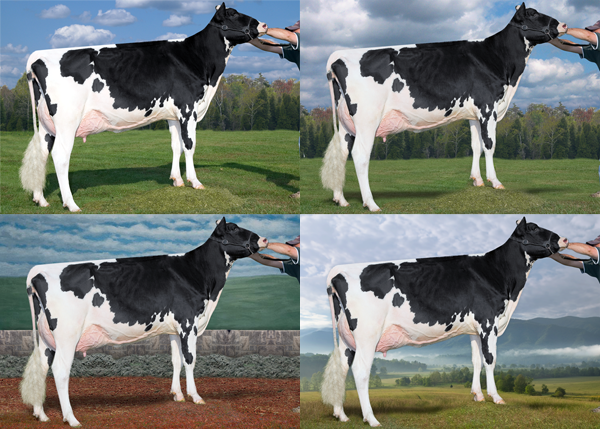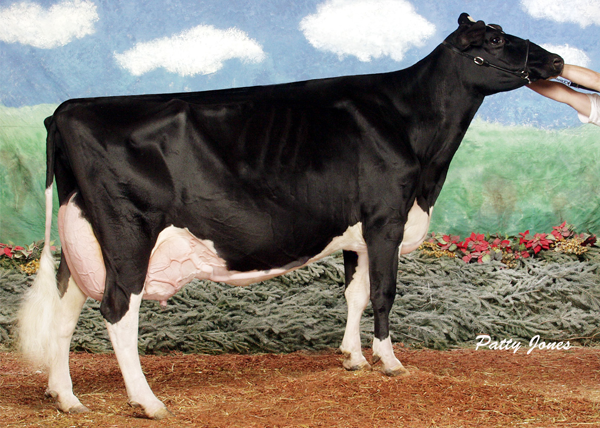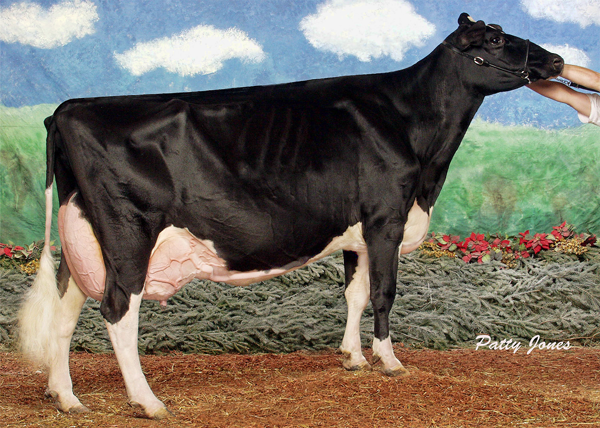Recently the Bullvine posted a judging contest on Facebook to see how breeders would place these six animals based on their pictures alone (Read more: Facebook image, entry form). The results were very interesting and raised the question “How well can you judge an animal from their picture?”
The animals selected, and more specifically, the pictures selected were all from photos that I have personally taken at shows. So there was no doubt that the animals appear as they appeared in the show ring this year (Read more: Introducing the Dairy Marketing Code of Conduct, Has Photo Enhancement Gone Too Far? and Dairy Cattle Photography – Over Exposed).
Of course we all know that No Cow is Perfect – Not Even in Pictures. What we are trying to figure out, is if these animals would place differently with pictures as compared to how they would place if they were judged side by side. The results were very interesting. Most people placed the class C-F-A-D-B-E and our official placing was F-C-D-A-E-B. F and C were a very very close placing, with only a slight split between them. They were followed closely by A, and then there was a decent split to D. The bottom pair of B and E could go either way.
The pictured placings were not too different, until you compare how these animals would place if you actually had them side by side. In that case, you would see a very different result F-D-C-A-E-B. F would take the class handily. You see F is Valleyville Rae Lynn, and C is Desnette Alexia Roseplex. These two cows have faced each other several times with the most recent time being at Ontario Summer Show (Read more: Ontario Summer Show Holstein Results and The Shocking Speed of Social Media and the Dairy Industry) where Rae Lynn won the class and went on to be Intermediate and Reserve Grand Champion and Roseplex was 3rd in that class. In the picture, Roseplex looks much deeper and more open of the rib. In real life she may be pretty close, but there are two things that you greatly miss in the picture that you can only see in real life. First is that Rae Lynn is just as deep and long. Since the leadsman of Roseplex is standing beside the cow instead of in front of her during this shot, we were able to crop in and so the cow appears that much larger. The other factor that you cannot see in just a side shot compared to being able to have the cows side by side is that Rae Lynn possesses much more width throughout. She is a much longer cow (another reason the pictures look different) and has a higher and wider rear udder.
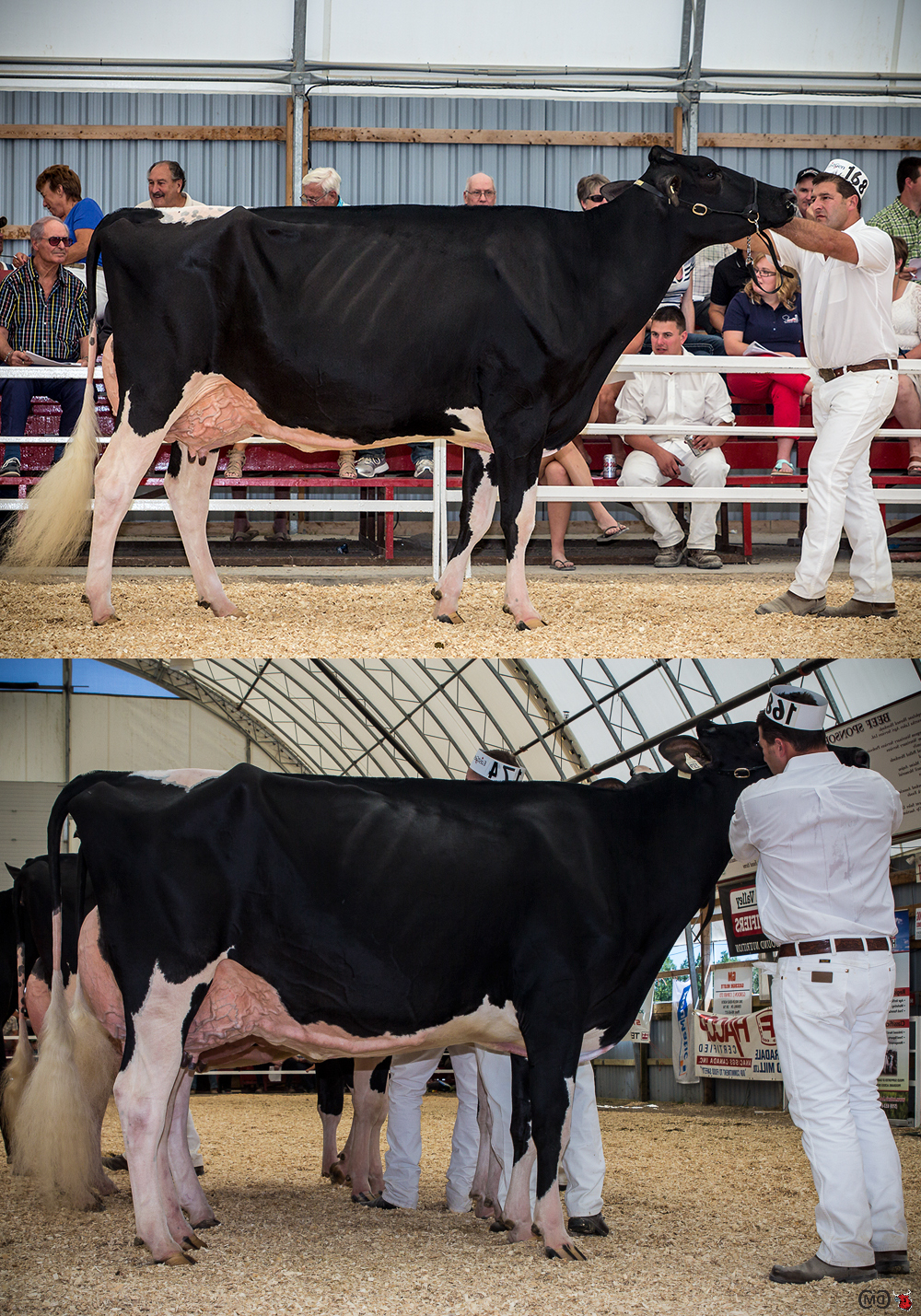
Valleyville Rae Lynn
It’s interesting to see just how cropping of a picture can change the way the animal looks.
The placing of D over C is where many may start to wonder what happened. We admit that in the pictures this is an easy placing of C over D, but if you had these in animals in the same ring at the same time, two factors would come into play. First that D, Eastriver Gold Deb 850, is again wider of the chest, higher of the rear udder and cleaner throughout. The second is that D would type in better with F (the class winner) and then would naturally follow her in the class. Similar to how Raivue Sanchez Pamela did at Ontario Summer Show and hence Roseplex (C) was placed 3rd at Summer Show (Read more: Ontario Summer Show Holstein Results). Something that you are not able to tell when judging pictures is also the stage of lactation. In this picture Deb 850 is fairly fresh where Roseplex is in mid lactation.
The other thing you would not realize in pictures, that you do when you see these cows, is that there is a size difference. This comes to play in our next placing of C over A. A, originally identified as Crater Indiana Goldwyn is actually Debeau Jasper December, she is a very balanced dairy cow but, with a live view, you would realize that she is not as much overall cow as the three above her. Also her rump, slope to hooks to pins, as well as width of rear udder would limit her from placing higher in this class.
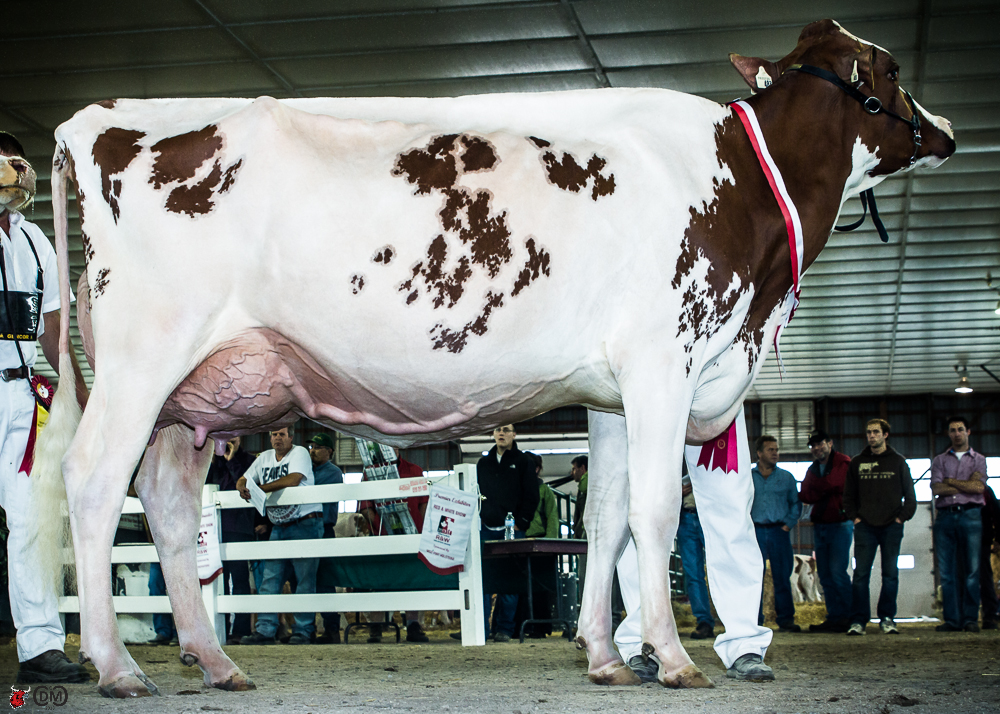
Huntshaven Deb Narobi Red
It’s amazing how much getting a lower perspective can change the appearance in a photograph.
The last two cows (E and B) also bring some interest to the class and not just because they are red. In this case, the difference is actually the quality of the picture. In both pictures the cows are not set up perfectly or looking their best. That was by design for this class. You see we have better pictures of E, Huntshaven Deb Narobi Red, and B Deslacs Ritzy Greedy Red. But what we wanted to point out here is just how animals can look very different depending on who is taking their photo. Both these cows are much better than their pictures would indicate. However, for me it is an easy placing putting E over B on the dairyness throughout and the quality of her fore udder. Yes Rizty Greedy Red is a very deep opened ribbed cow, but Narobi, is cleaner of the leg, smoother of the fore udder and longer throughout. The challenge you have with Narobi’s picture is that it is slightly over exposed here and so you cannot see her ribs as well as in Rizty Greedy Red’s picture. We intentionally used a slightly darker picture of Rizty Greedy Red and a slightly over exposed picture of Narobi to prove our point about what over exposing pictures does (Read more: Dairy Cattle Photography – Over Exposed).
The Bullvine Bottom Line
Let’s sit back and think about how often we don’t get to see many of the great cows in the world in person. Unless you are someone like Han Hopman (Read more: Han Hopman: Shooting Straight at Holstein International) or a select few that get the opportunity to get to the major shows around the world, you would never really be able to pick out exactly how all these great cows compare to each other. For example take Decrausaz Iron O’Kalibra *RC EX-96-SW (Read more: DECRAUSAZ IRON O’KALIBRA: Simply the Best). Many who have seen her as well as the top cows in North America admit that she is an extremely balanced cow and that her udder is amazing, though they wonder would she be enough cow to contend with the likes of Hailey on the North American show circuit. For those looking at both of them in pictures you could certainly go either way. O’Kalibra takes amazing photos and it can sometimes be hard to get as good a picture of Hailey as she looks in real life. And so the bottom line tells us it takes more than a picture to judge a cow.
Get original “Bullvine” content sent straight to your email inbox for free.





